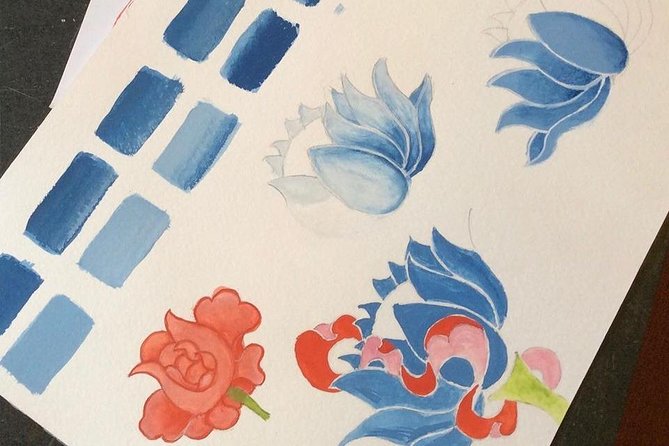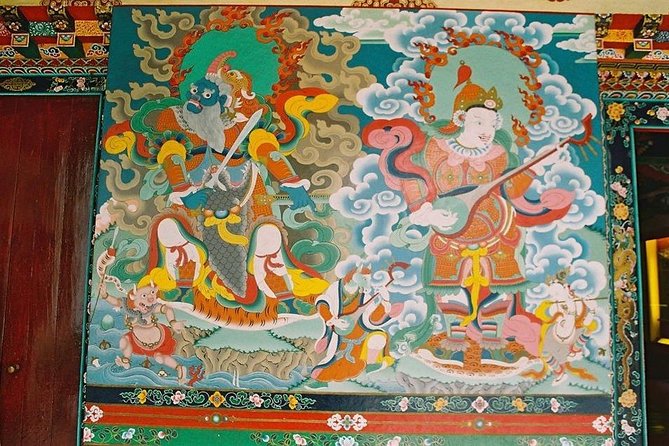In the bustling city of Kathmandu, Thanka shopping is a popular activity that allows visitors to enjoy the rich cultural heritage of Nepal. With over 100 Thanka shops scattered throughout the city, it’s no wonder that this traditional art form has become a significant part of the local economy.
Each year, thousands of travelers flock to Kathmandu in search of these exquisite hand-painted masterpieces, seeking to bring home a piece of the country’s vibrant spirituality. But what exactly is Thanka art, and why is it so highly valued?
Join us as we explore the fascinating world of Thanka shopping in Kathmandu and uncover the secrets behind these intricate artworks that have captivated the hearts of many.
Good To Know
- Thanka shopping in Kathmandu has a rich history and is a significant source of income for many individuals.
- Shopping in Kathmandu offers a wide variety of experiences, from street markets to upscale boutiques, with traditional designs being popular choices.
- The craftsmanship and authenticity of Thanka paintings in Kathmandu reflect the cultural heritage and traditions of Nepal.
- Bargaining is a common practice in Kathmandu, and popular destinations for Thanka shopping include Asan Tole market, Thamel area, Durbar Square, Boudha, and Patan.
History and Significance

The history and significance of shopping in Kathmandu can be traced back centuries, making it a fascinating destination for those seeking a unique and culturally rich retail experience. Over the years, shopping trends in Kathmandu have evolved, reflecting the changing tastes and preferences of locals and travelers alike.
From traditional markets to modern shopping malls, the city offers a diverse range of shopping experiences. The impact of shopping on the local economy can’t be underestimated. It serves as a major source of income for many individuals and contributes significantly to the growth of businesses and employment opportunities.
On top of that, the influx of travelers seeking authentic souvenirs and handicrafts has further boosted the economy, providing a platform for local artisans to showcase their talents and preserve their cultural heritage. Shopping in Kathmandu isn’t just about acquiring goods; it’s an immersive journey that connects people to the vibrant history and traditions of the city.
Enjoy shopping? Other Kathmandu market tours we've reviewed
Types and Styles
Kathmandu offers a wide variety of shopping experiences, ranging from bustling street markets to upscale boutiques, each showcasing its own unique types and styles.
When it comes to Thanka shopping, traditional designs are the popular choices among visitors and locals alike. Thanka paintings are traditional Tibetan Buddhist artworks that depict deities, mandalas, and religious scenes. They’re created using intricate brushwork and vibrant colors, making them visually stunning and culturally significant.
In Kathmandu, you can find Thankas in various sizes, from small pieces that fit in your hand to large wall hangings that can be the centerpiece of a room. The styles of Thankas also vary, with different schools of art and techniques being represented.
Whether you prefer the classic styles or more contemporary interpretations, there’s a Thanka for everyone’s taste in Kathmandu.
Authenticity and Quality

When shopping in Kathmandu, discerning buyers can find a remarkable blend of authenticity and quality in the products they encounter.
The craftsmanship exhibited in the local artwork is truly awe-inspiring. From intricately hand-carved wooden statues to vibrant paintings created with meticulous brushstrokes, each piece showcases the immense skill and dedication of the artisans.
The materials and techniques used in these artworks are deeply rooted in the cultural heritage of Nepal. The use of traditional methods passed down through generations ensures that the products maintain their authenticity and value.
Whether it’s a beautifully woven textile or a delicate metalwork piece, the attention to detail and commitment to preserving cultural heritage is evident in every item.
Shopping in Kathmandu allows buyers to not only acquire exquisite pieces but also support the local artisans and their rich artistic traditions.
Shopping Tips and Recommendations
For a truly immersive shopping experience in the vibrant city of Kathmandu, savvy shoppers can benefit from these expert tips and recommendations. When it comes to shopping etiquette in Kathmandu, it is important to remember that bargaining is a common practice. Don’t be afraid to negotiate the price, but do so respectfully. Plus, it is customary to remove your shoes before entering a shop, so be sure to follow this tradition. As for popular souvenirs, Kathmandu is famous for its exquisite Thanka paintings, traditional handicrafts, and colorful pashmina shawls. These items make for unique and meaningful keepsakes from your trip. To help you plan your shopping spree, here are some recommendations:
| Tips and Recommendations |
|---|
| Bargain respectfully |
| Remove shoes before entering shops |
| Buy Thanka paintings |
| Purchase traditional handicrafts |
| Get a colorful pashmina shawl |
Happy shopping in Kathmandu!
Prices and Bargaining
Prices and bargaining in Kathmandu offer a unique opportunity for shoppers to find great deals and enjoy the local shopping culture.
Here are some key aspects to consider when it comes to bargaining techniques and cultural etiquette in this vibrant city:
Friendly haggling: Bargaining is a common practice in Kathmandu, and shopkeepers expect it. Approach it with a smile and a friendly attitude to create a positive atmosphere.
Start low: Begin by offering a price significantly lower than the initial asking price. This allows room for negotiation and ensures you don’t pay more than necessary.
Patience is key: Bargaining in Kathmandu can take time, as both parties try to reach a fair agreement. Be patient and willing to walk away if the price doesn’t meet your expectations.
Respect cultural norms: Remember to be respectful of the local culture and customs while bargaining. Avoid being overly aggressive or disrespectful, as it can sour the interaction.
Where to Buy
After honing your bargaining skills and familiarizing yourself with the cultural etiquette of shopping in Kathmandu, it’s time to explore the various destinations where you can find unique and authentic items. Kathmandu offers a stack of options for shopping enthusiasts, from bustling markets to boutique stores.
One of the best places to start is the Asan Tole market, known for its vibrant atmosphere and a wide range of products, including thankas. If you’re looking for high-quality thankas, you can visit the Thamel area, which is popular among travelers and locals alike.
Another popular market is the Durbar Square, where you can find traditional Nepali handicrafts and artworks. For a more upscale shopping experience, head to the upscale stores in Boudha and Patan, where you can find exquisite thankas and other traditional items.
Whether you prefer the bustling markets or the curated stores, Kathmandu has a lot to offer.
Cultural and Symbolic Meanings
Cultural and symbolic meanings play a significant role in the shopping experience in Kathmandu, adding depth and significance to the items you may find. Here are four examples of how traditional practices and religious significance are intertwined in the local shopping culture:
Prayer flags: These colorful flags symbolize peace, compassion, and wisdom. Hanging them outside homes or temples is believed to bring good luck and ward off evil spirits.
Buddhist statues: Crafted with intricate details, these statues represent different deities and bodhisattvas. They aren’t just decorative items but also hold religious significance, serving as reminders of devotion and spiritual practices.
Mandala art: Mandalas, intricate geometric patterns, are often found in Thanka paintings and tapestries. These artworks are used in meditation and symbolize the universe and the interconnectedness of all beings.
Incense: Burning incense is a common practice in religious ceremonies and rituals. It’s believed to purify the environment, create a peaceful atmosphere, and please the deities.
In Kathmandu, shopping becomes more than just acquiring material possessions; it becomes a way to connect with the rich cultural heritage and spiritual traditions of Nepal.
Common Questions
Are There Any Specific Customs or Traditions Associated With Thanka Shopping in Kathmandu?
There are specific customs and traditions associated with thanka shopping in Kathmandu. The cultural significance of thanka paintings and the impact of tourism on the industry play a significant role in shaping the shopping experience.
Are There Any Specific Rituals or Ceremonies That Take Place During the Purchase of a Thanka Painting?
Specific rituals and ceremonies often accompany the purchase of a thanka painting. These traditions vary in different regions, but they typically involve blessings, prayers, and a symbolic exchange of offerings between the buyer and the seller.
Can Thanka Paintings Be Customized or Personalized According to Individual Preferences?
Yes, thanka paintings can be customized and personalized according to individual preferences. There are various customization options available, allowing customers to create a unique and meaningful artwork that suits their taste and requirements.
Are There Any Special Care Instructions or Maintenance Requirements for Thanka Paintings?
Special techniques and materials are used in thanka paintings, requiring special care. To properly display and store them, avoid direct sunlight and excessive humidity. Gentle dusting with a soft brush is recommended.
Are There Any Restrictions or Regulations on Exporting Thanka Paintings From Kathmandu?
Exporting thanka paintings from Kathmandu requires proper procedures and documentation, which may include obtaining necessary permits and licenses. The thanka painting industry in Kathmandu contributes significantly to the local economy, providing employment and promoting tourism.
The Sum Up
To sum it up, Thanka shopping in Kathmandu offers a captivating journey into the world of Buddhist art.
With its rich history and cultural significance, Thanka paintings are more than just beautiful artworks; they’re windows into spirituality and tradition.
By exploring the bustling marketplaces, identifying authentic pieces, and understanding the cultural meanings behind the art, visitors to Kathmandu can truly appreciate the ancient art form of Thanka and the vibrant cultural heritage it represents.
More Shopping Tours in Kathmandu
- Kathmandu Heritage Walking Tour With Local Market
- Nepali Traditional Dress (Sari Kurtha Wear) Shopping Tour
- Kathmandu Food Crawl & Market Tour
- Kathmandu Old City Tour: Asan Bazaar Evening Walking Tour
- Food Tour In Kathmandu With Walking Local Market
- Ultimate Sari and Kurtha Shopping Tour in Thamel |Kathmandu|
More Tour Reviews in Kathmandu
Looking for something different? Other Kathmandu activities we've written about
- 14 Best Shopping Tours In Kathmandu
- 25 Best Workshops And Classes In Kathmandu
- 18 Best Spa And Hot Springs Experiences In Kathmandu
- 20 Best Historical Tours In Kathmandu
- 15 Best Massage And Relaxation Services In Kathmandu
- 20 Best Helicopter Flights And Tours In Kathmandu
- 20 Best 3 Day Tours In Kathmandu
- 20 Best 4 Day Tours In Kathmandu
- 20 Best Private Driver Services In Kathmandu
- 20 Best Full-Day Tours In Kathmandu
- 25 Best Safari Tours In Kathmandu
- 4 Best Photography Experiences In Kathmandu
